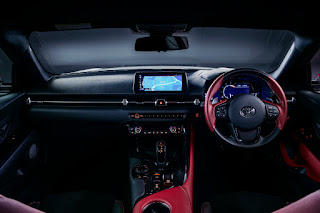Toyota GR Supra 2.0 vs. the GR Supra 3.0
Toyota has just begun selling the 2.0-litre version of its GR Supra in the UK.
Power comes from a 1,998 cc, four-cylinder, turbocharged engine which produces 258 PS (254 bhp / 190 kW) and up to 400 Nm (295 lb-ft) of torque. That output is sent to the rear wheels via an eight-speed ZF automatic transmission and an active differential.
By contrast, the existing GR Supra 3.0 features a 2,998 cc, in-line six-cylinder, turbocharged unit and an identical gearbox. Naturally, 340 PS (335 bhp / 250 kW) plus 500 Nm (368 lb-ft) result in superior performance.
However, in reality, the differences aren’t huge (at least according to the usual benchmarks).
Thanks partly to a lower kerb weight of 1,395 kg (3,075 lb) and standard launch control, the GR Supra 2.0 can accelerate from rest to 62 mph (100 km/h) in 5.2 seconds. While the heavier 1,495 kg (3,295 lb) 3.0-litre model takes 4.3 seconds to complete the same sprint, top speed for both variants is an electronically-limited 155 mph (250 km/h).
As would be expected, the new arrival is slightly more efficient, achieving 38.7 mpg (7.3 l/100km) with 167 g/km of CO2 emissions on the WLTP Combined Cycle. Equivalent figures for the GR Supra 3.0 are 34.4 mpg (8.2 l/100km) and 188 g/km respectively.
Interestingly, Toyota is claiming that the GR Supra 2.0 delivers sharper dynamics, primarily because its shorter motor helps with mass centralisation.
There’s a choice of Normal or Sport driving modes, too. The latter affects throttle response, gear-shift patterns, steering feel and behaviour of the Adaptive Variable Suspension (a continuously-variable damping system). Active Cornering Assist – which applies the brakes individually to control yaw motion – is fitted as well.
Initially, the 2.0-litre GR Supra is being offered in Pro guise. Therefore, the specification also includes 18” bi-tone double-spoke alloy wheels, heated front seats, black Alcantara upholstery, a reversing camera and an 8.8” infotainment touchscreen.
In addition, a special Fuji Speedway Edition is available from launch. A unique appearance combines white metallic paint, red door mirror caps, matt black 19” forged alloy wheels and, inside, a mix of black Alcantara and red leather. Just 45 examples have been allocated to the UK, though.
Ultimately, purchase cost could be what persuades customers to buy the smaller-capacity (but probably still quick enough) GR Supra 2.0. On-the-road starting prices for the 2021 line-up are:
Toyota unveils the one-off GR Supra Sport Top
Toyota GR Supra GT4 specifications confirmed
Toyota GR Supra versus Toyota GT86
Power comes from a 1,998 cc, four-cylinder, turbocharged engine which produces 258 PS (254 bhp / 190 kW) and up to 400 Nm (295 lb-ft) of torque. That output is sent to the rear wheels via an eight-speed ZF automatic transmission and an active differential.
By contrast, the existing GR Supra 3.0 features a 2,998 cc, in-line six-cylinder, turbocharged unit and an identical gearbox. Naturally, 340 PS (335 bhp / 250 kW) plus 500 Nm (368 lb-ft) result in superior performance.
However, in reality, the differences aren’t huge (at least according to the usual benchmarks).
Thanks partly to a lower kerb weight of 1,395 kg (3,075 lb) and standard launch control, the GR Supra 2.0 can accelerate from rest to 62 mph (100 km/h) in 5.2 seconds. While the heavier 1,495 kg (3,295 lb) 3.0-litre model takes 4.3 seconds to complete the same sprint, top speed for both variants is an electronically-limited 155 mph (250 km/h).
As would be expected, the new arrival is slightly more efficient, achieving 38.7 mpg (7.3 l/100km) with 167 g/km of CO2 emissions on the WLTP Combined Cycle. Equivalent figures for the GR Supra 3.0 are 34.4 mpg (8.2 l/100km) and 188 g/km respectively.
Interestingly, Toyota is claiming that the GR Supra 2.0 delivers sharper dynamics, primarily because its shorter motor helps with mass centralisation.
There’s a choice of Normal or Sport driving modes, too. The latter affects throttle response, gear-shift patterns, steering feel and behaviour of the Adaptive Variable Suspension (a continuously-variable damping system). Active Cornering Assist – which applies the brakes individually to control yaw motion – is fitted as well.
Initially, the 2.0-litre GR Supra is being offered in Pro guise. Therefore, the specification also includes 18” bi-tone double-spoke alloy wheels, heated front seats, black Alcantara upholstery, a reversing camera and an 8.8” infotainment touchscreen.
In addition, a special Fuji Speedway Edition is available from launch. A unique appearance combines white metallic paint, red door mirror caps, matt black 19” forged alloy wheels and, inside, a mix of black Alcantara and red leather. Just 45 examples have been allocated to the UK, though.
Ultimately, purchase cost could be what persuades customers to buy the smaller-capacity (but probably still quick enough) GR Supra 2.0. On-the-road starting prices for the 2021 line-up are:
- GR Supra 2.0 Pro – £45,995
- GR Supra 2.0 Fuji Speedway Edition – £47,395
- GR Supra 3.0 – £53,035
- GR Supra 3.0 Pro – £54,340
Toyota unveils the one-off GR Supra Sport Top
Toyota GR Supra GT4 specifications confirmed
Toyota GR Supra versus Toyota GT86





%2BDashboard.jpg)


+Front+Side.jpg)
+Front+Side.jpg)


Comments
Post a Comment